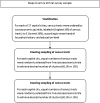Socioeconomic inequalities and vaccination coverage: results of an immunisation coverage survey in 27 Brazilian capitals, 2007-2008
- PMID: 22268129
- PMCID: PMC3433223
- DOI: 10.1136/jech-2011-200341
Socioeconomic inequalities and vaccination coverage: results of an immunisation coverage survey in 27 Brazilian capitals, 2007-2008
Abstract
Background: Since 1988, Brazil's Unified Health System has sought to provide universal and equal access to immunisations. Inequalities in immunisation may be examined by contrasting vaccination coverage among children in the highest versus the lowest socioeconomic strata. The authors examined coverage with routine infant immunisations from a survey of Brazilian children according to socioeconomic stratum of residence census tract.
Methods: The authors conducted a household cluster survey in census tracts systematically selected from five socioeconomic strata, according to average household income and head of household education, in 26 Brazilian capitals and the federal district. The authors calculated coverage with recommended vaccinations among children until 18 months of age, according to socioeconomic quintile of residence census tract, and examined factors associated with incomplete vaccination.
Results: Among 17,295 children with immunisation cards, 14,538 (82.6%) had received all recommended vaccinations by 18 months of age. Among children residing in census tracts in the highest socioeconomic stratum, 77.2% were completely immunised by 18 months of age versus 81.2%-86.2% of children residing in the four census tract quintiles with lower socioeconomic indicators (p<0.01). Census tracts in the highest socioeconomic quintile had significantly lower coverage for bacille Calmette-Guérin, oral polio and hepatitis B vaccines than those with lower socioeconomic indicators. In multivariable analysis, higher birth order and residing in the highest socioeconomic quintile were associated with incomplete vaccination. After adjusting for interaction between socioeconomic strata of residence census tract and household wealth index, only birth order remained significant.
Conclusions: Evidence from Brazilian capitals shows success in achieving high immunisation coverage among poorer children. Strategies are needed to reach children in wealthier areas.
Conflict of interest statement
Figures




Similar articles
-
Socioeconomic inequalities are still a barrier to full child vaccine coverage in the Brazilian Amazon: a cross-sectional study in Assis Brasil, Acre, Brazil.Int J Equity Health. 2014 Nov 27;13:118. doi: 10.1186/s12939-014-0118-y. Int J Equity Health. 2014. PMID: 25428334 Free PMC article.
-
Socio-economic determinants and inequities in coverage and timeliness of early childhood immunisation in rural Ghana.Trop Med Int Health. 2014 Jul;19(7):802-11. doi: 10.1111/tmi.12324. Epub 2014 Apr 28. Trop Med Int Health. 2014. PMID: 24766425
-
Vaccine coverage by social strata in state capitals in the Brazilian Midwest region: a household survey of children born in 2017 and 2018.Epidemiol Serv Saude. 2024 Nov 1;33(spe2):e20231308. doi: 10.1590/S2237-96222024v33e20231308.especial2.en. eCollection 2024. Epidemiol Serv Saude. 2024. PMID: 39504082 Free PMC article.
-
Systematic review of social determinants of childhood immunisation in low- and middle-income countries and equity impact analysis of childhood vaccination coverage in Nigeria.PLoS One. 2024 Mar 6;19(3):e0297326. doi: 10.1371/journal.pone.0297326. eCollection 2024. PLoS One. 2024. PMID: 38446836 Free PMC article.
-
Monitoring vaccination coverage: Defining the role of surveys.Vaccine. 2016 Jul 29;34(35):4103-4109. doi: 10.1016/j.vaccine.2016.06.053. Epub 2016 Jun 24. Vaccine. 2016. PMID: 27349841 Free PMC article. Review.
Cited by
-
Trends in inequality in maternal and child health and health care in Uganda: Analysis of the Uganda demographic and health surveys.BMC Health Serv Res. 2022 Oct 20;22(1):1269. doi: 10.1186/s12913-022-08630-x. BMC Health Serv Res. 2022. PMID: 36266643 Free PMC article.
-
Vaccination Coverage and Compliance with Three Recommended Schedules of 10-Valent Pneumococcal Conjugate Vaccine during the First Year of Its Introduction in Brazil: A Cross-Sectional Study.PLoS One. 2015 Jun 10;10(6):e0128656. doi: 10.1371/journal.pone.0128656. eCollection 2015. PLoS One. 2015. PMID: 26061276 Free PMC article.
-
Vaccination coverage, vaccine hesitancy and factors associated with incomplete vaccination: a household survey conducted with children born between 2017 and 2018 in the inland municipalities of Northeastern Brazil.Epidemiol Serv Saude. 2025 Jan 10;33(spe2):e20231224. doi: 10.1590/S2237-96222024v33e20231224.especial2.en. eCollection 2025. Epidemiol Serv Saude. 2025. PMID: 39813543 Free PMC article.
-
Spatial analysis of vaccine coverage on the first year of life in the northeast of Brazil.BMC Public Health. 2022 Jun 16;22(1):1204. doi: 10.1186/s12889-022-13589-9. BMC Public Health. 2022. PMID: 35710366 Free PMC article.
-
Prevalence, Trends and Conditions for the DTP3 Vaccine: A 25-Year Historical Perspective.Risk Manag Healthc Policy. 2021 Oct 14;14:4301-4310. doi: 10.2147/RMHP.S312263. eCollection 2021. Risk Manag Healthc Policy. 2021. PMID: 34703341 Free PMC article.
References
-
- Temporão JG. [Brazil's national immunization program: origins and development]. Hist Cienc Saude Manguinhos 2003;10:601–17 - PubMed
-
- Brazil Gov Federal Law 7649/1988. Brasília. DOU January 25, 1988
-
- Moraes JC, Barata R, Ribeiro MC, et al. [Vaccination coverage in the first year of life in 4 cities of the state of Sao Paulo, Brazil]. Rev Panam Salud Publica 2000;8:332–41 - PubMed
-
- Brazilian Ministry of Health [Basic Immunization Calendar for Children]. 2008. http://portal.saude.gov.br/portal/saude/visualizar_texto.cfm?idltxt=21462 (accessed 5 Feb 2009).
Publication types
MeSH terms
Substances
LinkOut - more resources
Full Text Sources
Medical
